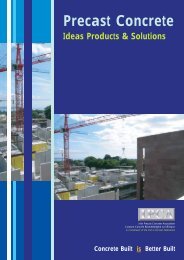Concrete Today May 2010 - the Irish Concrete Federation
Concrete Today May 2010 - the Irish Concrete Federation
Concrete Today May 2010 - the Irish Concrete Federation
Create successful ePaper yourself
Turn your PDF publications into a flip-book with our unique Google optimized e-Paper software.
concrete today - designing for earthquake - precast concrete<br />
cases of mass construction of Precast<br />
structures, speed of construction and low<br />
cost featured more as design considerations,<br />
ra<strong>the</strong>r than ‘conceptual design aspects’<br />
which would contribute to increased safety<br />
against earthquakes, even taking into<br />
account <strong>the</strong> more limited level of scientific<br />
knowledge at that time.<br />
In this respect, <strong>the</strong> case of <strong>the</strong> Armenia<br />
earthquake of 1989 is worth mentioning<br />
in which, among o<strong>the</strong>r damage, two<br />
cities in particular, Leminakan and<br />
Spitak which were built extensively using<br />
prefabrication techniques were completely<br />
destroyed. According to <strong>the</strong> findings of <strong>the</strong><br />
International Scientific Community, <strong>the</strong><br />
extent of <strong>the</strong> disaster was not due to <strong>the</strong> use<br />
of prefabrication itself but, much more due<br />
to completely inefficient design concepts,<br />
e.g. lack of proper lateral resisting systems,<br />
very bad detailing of Precast members<br />
and <strong>the</strong>ir connections and finally very bad<br />
quality of <strong>the</strong> concrete and improper use<br />
of steel.<br />
Such cases and o<strong>the</strong>r cases of collapse of<br />
Precast structures after strong earthquakes<br />
in <strong>the</strong> past (Kocaeli earthquake 1999,<br />
Northridge earthquake 1994, Vrancea<br />
earthquake 1977 etc), gave <strong>the</strong> ra<strong>the</strong>r<br />
unjustified impression to <strong>the</strong> international<br />
community that Precast concrete<br />
constructions performed poorly under seismic<br />
actions due to <strong>the</strong> fact that prefabrication was<br />
used.<br />
Findings of International Scientific<br />
Community<br />
Never<strong>the</strong>less, according to <strong>the</strong> findings of<br />
<strong>the</strong> International Scientific Community,<br />
it is a fact that <strong>the</strong>re are many examples of<br />
excellent behaviour of Precast structures, if<br />
properly designed and constructed in a way<br />
which takes into account <strong>the</strong> fundamental<br />
requirements of non-collapse and damage<br />
limitation, within acceptable cost limits. In<br />
this respect it is worth mentioning that <strong>the</strong><br />
only buildings which survived <strong>the</strong> strong<br />
earthquake motions in one of <strong>the</strong> above<br />
mentioned two cities of Armenia were some<br />
multi-storey large-panel buildings which<br />
were designed and constructed, taking into<br />
account basic conceptual design aspects.<br />
L’Aquila earthquake central Italy 2009<br />
Considerable research has been reported<br />
worldwide in <strong>the</strong> last decades due to <strong>the</strong><br />
work of individual companies and by<br />
relevant institutions, which has contributed<br />
to <strong>the</strong> reliability of Precast structures<br />
built in seismic regions. Among <strong>the</strong>m <strong>the</strong><br />
PRESS (Precast Seismic Structural System)<br />
research programme carried out by <strong>the</strong><br />
USA and Japan may be considered <strong>the</strong><br />
most notable experimental investigation<br />
of <strong>the</strong> response of Precast structures to<br />
earthquake. Through this research project,<br />
new concepts and technologies have<br />
been invented and experimentally and<br />
<strong>the</strong>oretically supported, using innovative<br />
connections and prestressing.<br />
The SAFECAST Programme<br />
In March 2009, a new European<br />
Research Programme was initiated,<br />
entitled SAFECAST – Performance of<br />
innovative mechanical connections in<br />
Precast building structures under seismic<br />
conditions’ , financed under <strong>the</strong> 7th<br />
L’Aquila earthquake central Italy 2009<br />
Framework Programme ‘Research for<br />
Small and Medium Enterprises (SME)<br />
Associations action’. The project derives<br />
from two previous research projects, <strong>the</strong><br />
ECOLEDER and <strong>the</strong> PRECAST EC8<br />
project and completes <strong>the</strong>m thoroughly.<br />
Both of <strong>the</strong>se projects dealt with <strong>the</strong><br />
seismic behaviour and ductility capacity<br />
of Precast concrete structures compared<br />
to corresponding cast insitu structures.<br />
However, it was clear from <strong>the</strong> findings<br />
that <strong>the</strong> actual design of <strong>the</strong> connections<br />
was not fully covered and <strong>the</strong>refore<br />
difficult to be modelled properly for<br />
<strong>the</strong> numerical studies used in <strong>the</strong> design<br />
of Precast building structures. Thus,<br />
SAFECAST has been established to<br />
investigate, both experimentally and<br />
numerically, <strong>the</strong> seismic behaviour of<br />
several types of connections between<br />
Precast members. The success of this<br />
project is critical to <strong>the</strong> design of Precast<br />
concrete structures, as reliable as cast<br />
insitu concrete structures.<br />
concrete today<br />
7





